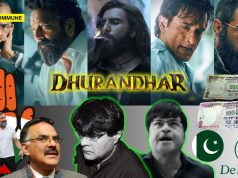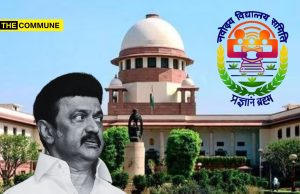
Looking at the camaraderie between the leaders of Congress and DMK in Tamil Nadu today, one can only laugh at the plight of the Congress party and the levels to which it had been reduced to. Except for the issue of acquitting the killers of Rajiv Gandhi, there seems to be no difference between the Congress and the DMK. The former finds itself shamelessly sucking up to the latter to remain relevant in today’s Tamil Nadu politics.
It should be noted that the Justice Party, the parent organization of the DMK, and the Congress were ideologically opposed at one point, and some senior Justice Party leaders went on a public tirade against Congress leaders. Justice Party leaders made reference to the Congress as a “Brahmin” party, a term they now use to refer to the BJP. Congress also criticized the leaders of the ‘Justice Party’ for their feudal mindset. They referred to the leaders of the ‘Justice Party’ as land-owning, dominant, non-Brahmin caste leaders.
DMK leaders and sympathizers of the party who claim to be flagbearers of social justice often boast how the Justice Party had been born out of struggles for the oppressed. However, a deep look into the history will reveal that the party was born out of hate and personal vendetta.
Justice Party, a party formed by ego-hurt landed wealthy caste leaders
The Tamil Nadu Congress formed the government in Tamil Nadu after securing a landslide majority in the 1937 provincial elections and decimating the Justice Party, which did not emerge after that election. The journey of ‘Justice Party’ from its inception in 1916 to its decimation in 1937 election is worth remembering.
TM Nair and PT Thiyagaraya Chettiar were founding members of the Justice Party. The story of how they started the Justice Party is important to know.
TM Nair was in Congress before starting the Justice Party. He presided over the North Arcot Congress conference at Chittoor in 1907. He was elected to the Madras Corporation in 1904, representing the Thiruvallikkeni constituency, which is dominated by Brahmins. He was elected to the same constituency three times in a row subsequently. However, when he contested for the Imperial Legislative Assembly in the same constituency in 1916, he was defeated. He came to the startling conclusion that the Brahmins who lived there were to blame for his election defeat, and this failure prompted him to start a non-Brahmin party.
PT Thiyagaraya Chettiar was also a member of Congress before starting the Justice Party along with TM Nair. Thiyagaraya Chettiar once donated more than ₹10,000 to the Kumbabhishekam of the Mylapore Kabaliswarar Temple. When he arrived at the ceremony, he was denied a seat on the stage. There were many brahmins seated on stage, and he felt insulted since no one invited him to be on stage. Thiyagaraya Chettiar, unable to tolerate what he saw as caste arrogance, was driven to start a non-Brahmin party.
TM Nair and Thiyagaraya Chettiar, both affluent and educated, founded the non-Brahmin party because their personal interests were hurt and not for the cause of oppressed people. Both would not have founded Justice Party if TM Nair had won the Imperial election in 1916 and Thiyagaraya Chettiar had been given a seat beside brahmins on stage. They started the party because they felt insulted in front of brahmins and not for the sake of the upliftment of the downtrodden.
Although certain Dalit leaders were linked to EV Ramasamy and the Justice Party, they did not agree with them on all issues. That relationship was in the form of the enemy’s enemy is our friend sort of relationship. Even back then, oppressed community leaders criticized EVR and the Justice Party on a number of issues. This is because the Justice Party’s leaders primarily cared about the upliftment of their own castes and ignored the poor.
The history of leaders like M. Krishnasamy, Veerasamy, L.C. Kurusami, Rao Bahadur Jagannathan, Annai Meenambal Sivaraj, Jyoti Venkitachellam, M.C.Raja, and Diwan Bahadur Rettamalai Srinivasan, who truly battled for the oppressed, was viciously suppressed by Dravidian leaders.
The end of Justice Party:
After boycotting the 1920 election owing to the Non-Cooperation Movement, Congress chose to contest in the 1937 provincial election, raising the aforementioned problems with Madras Presidency voters and labeling Justice Party leaders as British stooges.
The Indian National Congress obtained a majority by winning 159 of 215 seats in the Legislative Assembly. This was the first electoral victory for the Congress in the presidency since elections were first conducted for Madras Legislative Council in 1920. The Justice Party which had ruled the presidency for most of the previous 17 years was voted out of power. The Assembly was constituted in July 1937 and C. Rajagopalachari (Rajaji) became the first Congress Chief Minister of Madras.
The Justice Party was demoralized by its defeat and the Raja of Bobbili temporarily retired from active politics. Many incumbent ministers of the Justice Government were defeated in this election. Chief Minister Raja of Bobbili, Kumararaja of Venkatagiri, P. T. Rajan, A. P. Patro, and the Raja of Ramnad were among the Justice Party leaders who were defeated. The party remained in the political wilderness and eventually came under the control of Periyar EV Ramasamy in 1938 and transformed into the Dravidar Kazhagam in 1944.
Current congress leaders in Tamil Nadu have forgotten this past, and some have even teamed up with state parties to refer to the Indian government as the “Union” government, which is fueling separatism. The sheer rudderless of the Congress has effected the party becoming a stooge of its own nemesis.




